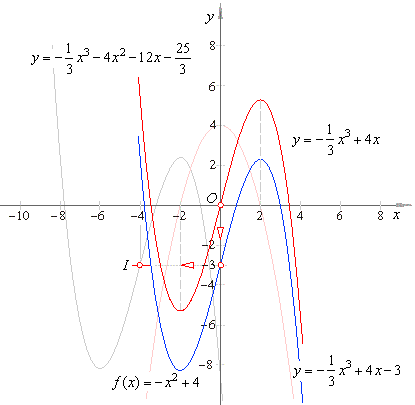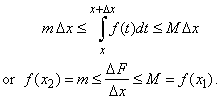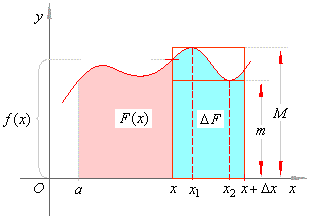|
| Integral
calculus |
|
 The indefinite integral
The indefinite integral |
|
Evaluating the indefinite integral example |
|
|
|
|
|
|
|
| Evaluating
the indefinite integral example |
| Example:
Given
f (x) = -
x2 + 4, find
its antiderivatives or primitive functions
F (x)
and draw their graphs. |
| Solution: Since
an indefinite integral is any function F
(x)
whose derivative is given f
(x),
then |
 |
| Therefore,
obtained primitive functions F
(x)
are
represented by all source cubic functions y
= a3x3 + a1x
whose
graphs are translated in the direction of the y-axis
by y0
= C. |
| Let
for example C = -
3 then, the translated cubic y = (-1/3)x3
+ 4x -
3 represents one particular antiderivative
F (x),
as is shown in the figure below (colored blue). |
 |
| If,
the graph of F (x)
we now translate, or move horizontally in the direction of x-axis
by x0 = -
4, that is, |
 |
| we
get the cubic explored in the section ' Applications
of differentiation - the graph of a function and its derivative'. |
|
| Let's
prove that the differentiation of an indefinite integral with respect to
the variable upper limit yields the function
that
is integrated, the integrand. |
| Let
write the increment DF
of the difference quotient DF/Dx |
 |
| As f
(x)
is continuous function in the closed interval [x,
Dx]
it takes its maximal value M
and minimal value m
at some points, x1
and x2,
as is shown in the right
figure. |
| Therefore,
according to the mean value theorem |
 |
|
 |
|
| Now,
as Dx
®
0
then x
+ Dx
tends to x,
and since f
is continuous then f
(x1)
and f (x2)
approach f (x). |
| Thus, |
 |
|
|
that is, by differentiating the indefinite integral of a
continuous function with respect to
the upper limit x
we get the
function that
is integrated (the integrand). Hence, we also can write |
 |
| that
is, by integrating the derivative F' (x),
or the differential dF,
we get the antiderivative F(x). |
| Therefore,
differentiation and integration are inverse-related operations, when
successively performed on the same
continuous function, the function stays unchanged. So, by integrating a
continuous function f
we get a new
function which, when differentiated, leads back to the original function
f. |
| This property we use to check the result of integration thus, by differentiating the result of integration we must obtain the integrand
(the function that is integrated). |
| Similarly,
differentiation of the indefinite integral with respect to
the lower limit we write as |
 |
| so
that, F' (x)
dx
= -
f (x). |
| Therefore,
the indefinite integral of a continuous function f
(x)
is any of its antiderivatives or primitive functions (whose derivative is
f (x)). |
|
|
|
|
|
|
|